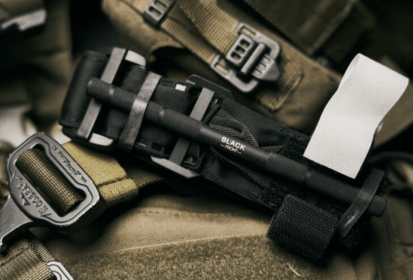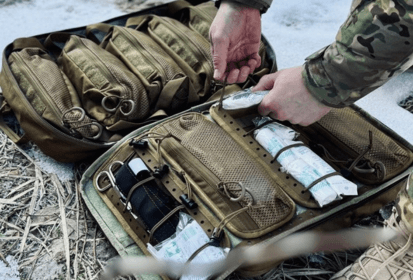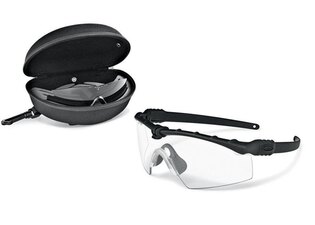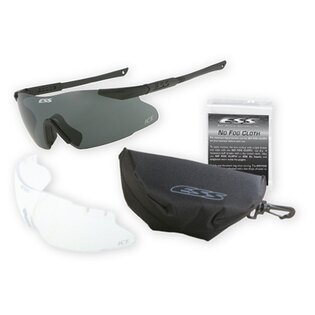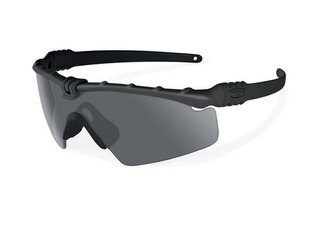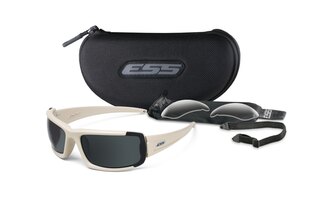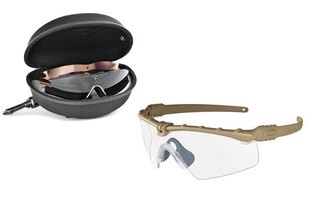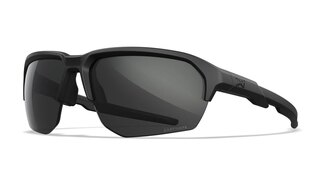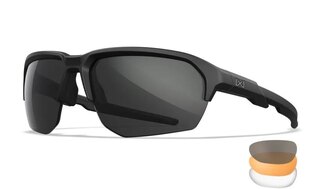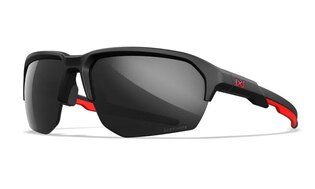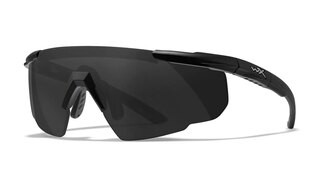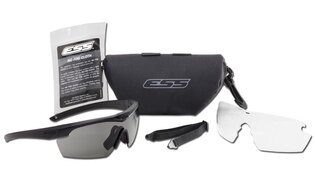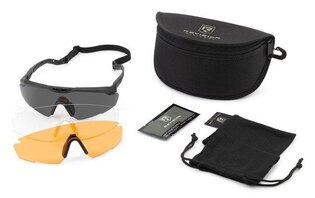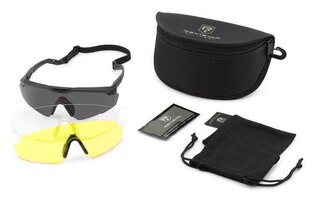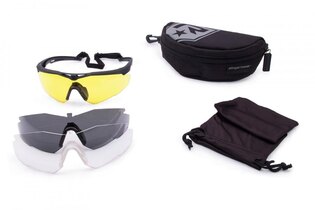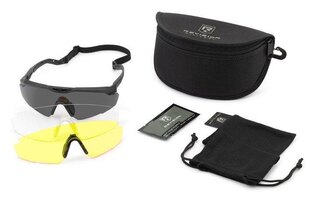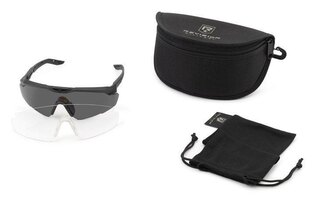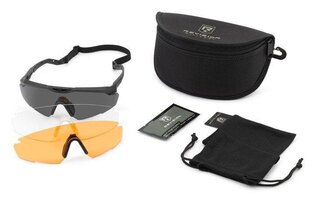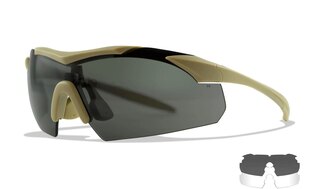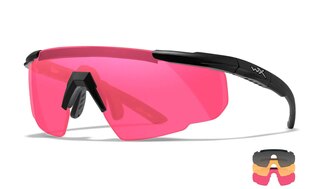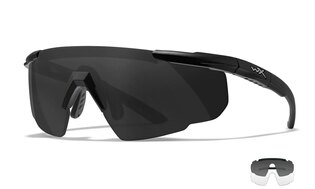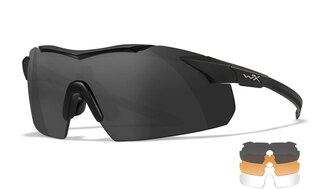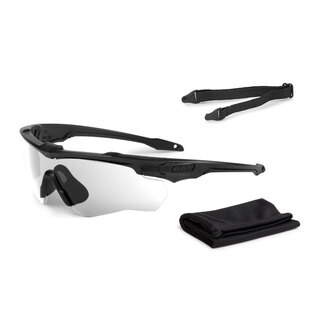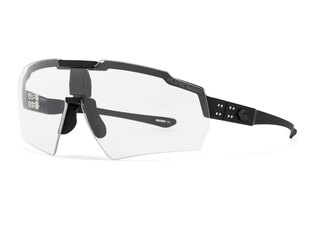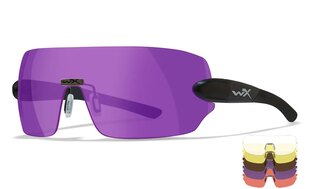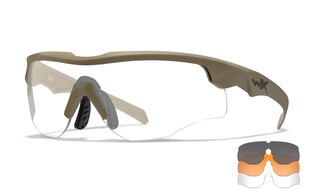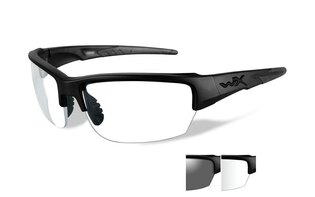Guide to Choosing Shooting, Tactical, and Ballistic Eyewear 2025
Shooting, tactical, and ballistic eyewear is not just another pair of sunglasses. Their job is to protect your vision from ricocheting fragments, muzzle blast pressure, and high-speed debris. In this article, we explain the differences between the various types of eyewear, introduce the main safety standards they should meet, and show you specific models you can’t go wrong with.
This article follows up on our previous guide to choosing sunglasses, sports, and outdoor eyewear. This time, we focus on models designed specifically for shooting and tactical use. Compared to ordinary sunglasses or sports glasses, they offer higher ballistic protection, must be compatible with helmets and headsets, and their lenses undergo stricter scratch-resistance and durability testing.
Standards and certifications play a key role. To be labeled tactical or ballistic, eyewear must meet prescribed requirements. The most common are:
- EN 166 – European standard for eye and face protection at work
- ANSI Z87.1 – U.S. standard defining baseline requirements for protective eyewear
- MIL-PRF – U.S. military standard for ballistic resistance in combat conditions
👉 With these certifications, you can be confident that your eyewear will perform even in demanding scenarios where regular sports glasses would fail.
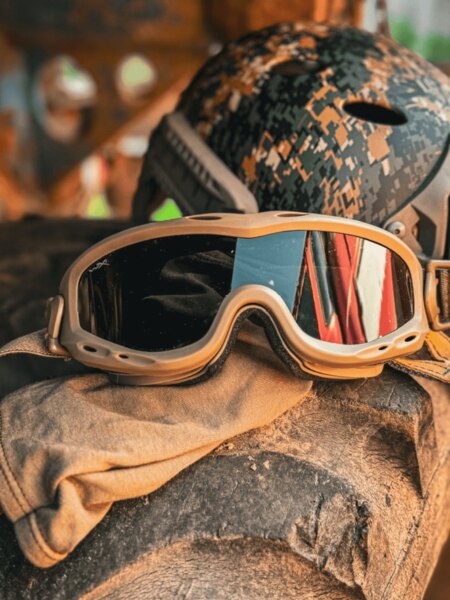
Tactical protective goggles with a smoke lens combined with a helmet – demonstration of equipment for field use and environments with dust or wind.
Quick Summary for Those in a Hurry
5 quick tips for choosing eyewear
- For the shooting range, shooting glasses are usually enough (min. EN 166 / ANSI Z87.1) with clear or grey lenses.
- For the field and with gear, consider tactical glasses (higher durability, thin temples for headset use).
- For the highest protection and against fragments, go for ballistic goggles.
- Polarization may distort the view through optics — usually unsuitable for shooting.
- Wear prescription lenses? Look for a model with an RX insert (prescription carrier).
Types of Protective Eyewear for Shooters: Shooting, Tactical & Ballistic
Not all protective eyewear is created equal. Different types are suitable for the shooting range, duty use, or real deployment – varying in protection level, gear compatibility, and lens options. Here’s a quick overview to help you pick the right type.
🔵 Shooting Glasses (for range and sport training)
Designed for civilian sport shooting and training. Lightweight, comfortable, and protective against ricochets, wind, and muzzle blast. Typically certified to EN 166 (F) or ANSI Z87.1.
Shooting Glasses (for range and sport training)
🔵 Tactical Glasses
More robust build, higher resistance, and solid compatibility with helmets, headsets, and NVG. Aimed at duty use, airsoft/paintball, and harsher environments. Often certified to MIL-PRF-32432 or STANAG 2920.
Tactical Glasses (for field use and gear)
🔵 Ballistic Glasses
Made for combat deployment and environments with ballistic fragment risk. Usually certified to STANAG 4296 or MIL-PRF-31013; often provide larger facial coverage, sometimes with goggle/semi-mask style or sealed designs for dust and smoke protection.
Ballistic Glasses (maximum protection and coverage)

Light shooting glasses with a clear lens on the shooting range table – ideal for practice, easily combinable with headphones.
Standards and Ballistic Tests – At a Glance
| Standard | What it verifies | Example test / scope | Suitable for |
|---|---|---|---|
| EN 166 (F/B/A) | Eye protection in work and sports, impact resistance, optical quality. | Small object impacts at defined velocity; field of vision and surface resistance requirements. | Work, sports, civilian shooting ranges. |
| ANSI Z87.1 (USA) | Baseline safety of protective eyewear, including impact and optics. | High Velocity (fast small projectiles) and High Mass (falling heavier object). | Protective eyewear in the US, shooting ranges, industry. |
| MIL-PRF-32432 (military eyewear) | Ballistic resistance, optical quality, and environmental durability. | Fragmentation tests (V0/V50), mechanical and environmental stress. | Tactical deployment, field training, duty use. |
| STANAG 2920 | Ballistic resistance against fragments using the V50 metric. | Fragment Simulating Projectiles (FSP); determines velocity at which 50% of projectiles are stopped. | Ballistic glasses/goggles, military testing. |
| STANAG 4296 | Requirements for combat eyewear (ballistics, comfort, field of view, compatibility). | Specification for combat-use eyewear; often referencing results from 2920. | Ballistic glasses intended for conflict zones. |
| MIL-PRF-31013 (legacy) | Older military eyewear specification; still found in some models. | Fragmentation tests, optics, surface durability. | Selected tactical/ballistic models. |
What the main tests mean
- High Velocity (ANSI Z87.1) – impact of a small projectile at high speed; verifies resistance to fast-moving fragments.
- High Mass (ANSI Z87.1) – impact from a heavier object; simulates blunt force strikes/shocks.
- V50 (STANAG 2920 / MIL-PRF) – velocity at which 50% of projectiles are stopped; core metric of fragmentation resistance.
- Environmental – tests for temperature (e.g. −40 °C to +70 °C), UV, humidity, dust, chemical exposure (fuels, sweat, oils).
Key Features and Technologies
Eyewear for shooting and tactical use differs mainly in durability (standards), lens systems, coatings, UV protection, and compatibility with helmets and headsets. Here’s what matters most.
Resistance and Certification (What’s the Minimum?)
For safe civilian range use, look for at least EN 166 or ANSI Z87.1. For field and duty use, go with MIL-PRF or STANAG models.
Details about the tests (High Velocity/High Mass, V50, etc.) can be found above in the section “Standards and Ballistic Tests”.
Visible Light Transmission (VLT) & Interchangeable Lenses
VLT indicates how much light passes through the lens.
⚪️ Clear: universal for training and indoor use, maximum detail visibility
🟡 Yellow/amber/orange: boost contrast in poor light (morning/dusk/fog)
⚫️ Smoke grey: low VLT for bright conditions, neutral color perception
👉 Quick lens swaps based on lighting are highly practical; in duty-grade models, this is standard.
Lens Coatings (Antifog, Antiscratch, Hydro/Oleo, AR)
- Antifog – prevents fogging (essential for sealed designs and masks)
- Antiscratch – harder coating to resist scratches
- Hydrophobic/oleophobic – repels water, sweat, and grease → easier cleaning
- AR (anti-reflective) – reduces glare, improves contrast
Polarization: can distort the view through shooting optics — often making it unsuitable for firearms use.
UV Protection
Quality protective eyewear typically blocks 99–100% of UV light regardless of lens tint. Even clear lenses can provide full UV protection – darkness isn’t a requirement.
Helmet & Headset Compatibility
Correct shape and construction improve comfort and safety:
- Thin temples/low profile → no pressure under headset or helmet edge
- Frame shape → should not restrict peripheral vision; must seal without gaps
- Goggles with strap → best compatibility with helmets and masks; look for good ventilation (antifog/venting channels)
Prescription Inserts (RX)
Need corrective lenses? Look for models with an RX insert – an internal carrier for your prescription lenses. The outer shield stays ballistic-certified, and you can swap lens colors/types as needed.
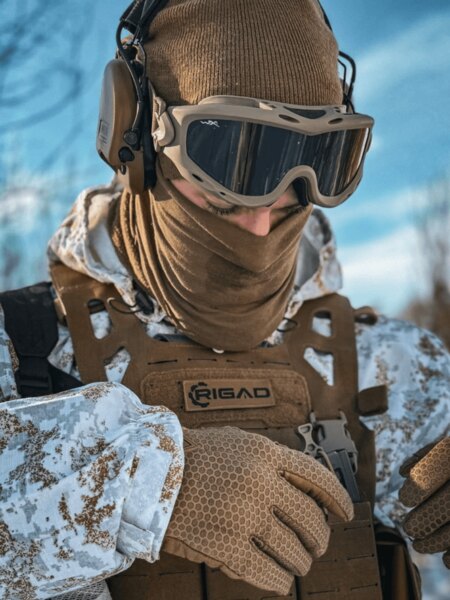
Winter use: goggles with headset and gear – example of proper compatibility of goggles, hearing protection, and helmet.
Lens Colors and Types for Shooters
Lens color and VLT define what and how well you see. Choose according to lighting and purpose; for shooting, non-polarized lenses are usually recommended due to optics compatibility.
Lens Colors and Types for Shooters
Lens color and VLT (Visible Light Transmission) determine what you see and how clearly. Choose based on lighting and purpose; for shooting, non-polarized lenses are generally recommended due to compatibility with optics.
Materials and Construction
Durability, functionality, and long-wear comfort are priorities for shooting, tactical, and ballistic eyewear.
Lens Materials
- Polycarbonate – most common in shooting/tactical eyewear; highly impact-resistant, lightweight, affordable. Slightly less optical clarity than glass, but far lighter.
- Trivex (NXT/Trilogy) – modern alternative; similar impact resistance, better optics, higher price.
- (Glass – generally not used; heavy, brittle, unsuitable for ballistic safety.)
Frame Materials
- Nylon / Grilamid TR90 (polyamide) – flexible, durable, handles bending and temperature changes well; standard for tactical eyewear.
- Composites and special polymers – high resistance to cracking/deformation; common in military models and goggles.
- Metals – not used in this category (risk of deformation and injury).
Ergonomics and Comfort
- Thin, low-profile temples – better helmet/headset compatibility
- Soft, adjustable nose pads (TPR/TPE/silicone) – reduce pressure, improve stability
- Goggle ventilation + antifog layers – fight fogging
- Non-slip temple tips + RX option – user comfort and vision correction without losing ballistic rating
- Lightweight construction – critical for all-day wear
Lens Coatings: (antifog, antiscratch, hydro/oleo, AR) are described above in the section “Key Features and Technologies”.
Brands and Recommended Models at Rigad
At Rigad, we carry proven brands in the shooting, tactical, and ballistic eyewear category – long trusted by professionals: Wiley X, Oakley SI, ESS, Bollé. Below you’ll find a selection of models, who they’re for, what makes them stand out, and which certifications (depending on version) they meet. Always double-check specific certifications and VLT details in the product description.
Spear Dual Wiley X®
ESS® ICE™ 2LS 2.4 Eyeshield Set
ESS® ICE™ CDI
M-Frame 3.0 Array SI Oakley®
Summary and Recommendations: How to Choose Shooting, Tactical & Ballistic Eyewear
The right eyewear is not cosmetics – it’s eye protection in situations where ordinary sunglasses won’t cut it. Decide based on environment and purpose, check certifications, choose appropriate VLT, and ensure helmet/headset compatibility. If you wear prescription lenses, go for RX-insert models – they preserve ballistic certification while letting you swap lenses by lighting conditions.
Final pre-purchase checklist:
✅ Purpose: range = min. EN 166 / ANSI Z87.1; field/duty = MIL-PRF / STANAG
✅ Lenses: universal clear + smoke grey; yellow/amber for low light; avoid polarized with optics
✅ Fit & comfort: thin temples, good ventilation (esp. goggles), gap-free seal
✅ Prescription: model with RX insert
✅ Product details: verify exact certifications, VLT, and included lenses/accessories
Not sure? Write to us – we’ll help you match eyewear to your gear and shooting conditions. Or go straight for our recommended models above: Wiley X® Spear Dual, ESS® ICE™ 2LS 2.4 Eyeshield, ESS® ICE™ CDI, and Oakley® SI M-Frame 3.0 Array.
Readers are further interested
